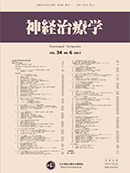33 巻, 6 号
選択された号の論文の18件中1~18を表示しています
- |<
- <
- 1
- >
- >|
-
2016 年 33 巻 6 号 p. 617
発行日: 2016年
公開日: 2017/04/30
PDF形式でダウンロード (222K)
Editorial(論説)
-
2017 年 33 巻 6 号 p. 619-620
発行日: 2017年
公開日: 2017/04/30
PDF形式でダウンロード (333K)
特集 免疫介在性壊死性ミオパチー
-
2017 年 33 巻 6 号 p. 621
発行日: 2017年
公開日: 2017/04/30
PDF形式でダウンロード (200K) -
2017 年 33 巻 6 号 p. 622-626
発行日: 2017年
公開日: 2017/04/30
PDF形式でダウンロード (2119K) -
2017 年 33 巻 6 号 p. 627-632
発行日: 2017年
公開日: 2017/04/30
PDF形式でダウンロード (408K) -
2017 年 33 巻 6 号 p. 633-637
発行日: 2017年
公開日: 2017/04/30
PDF形式でダウンロード (1126K)
原著
-
2017 年 33 巻 6 号 p. 638-641
発行日: 2017年
公開日: 2017/04/30
PDF形式でダウンロード (913K) -
2017 年 33 巻 6 号 p. 642-645
発行日: 2017年
公開日: 2017/04/30
PDF形式でダウンロード (447K) -
2017 年 33 巻 6 号 p. 646-651
発行日: 2017年
公開日: 2017/04/30
PDF形式でダウンロード (1276K)
-
2017 年 33 巻 6 号 p. 653-688
発行日: 2017年
公開日: 2017/04/30
PDF形式でダウンロード (7916K)
神経治療最前線 海外学会参加報告
-
2017 年 33 巻 6 号 p. 689-690
発行日: 2017年
公開日: 2017/04/30
PDF形式でダウンロード (514K) -
2017 年 33 巻 6 号 p. 691-692
発行日: 2017年
公開日: 2017/04/30
PDF形式でダウンロード (762K) -
2017 年 33 巻 6 号 p. 693-696
発行日: 2017年
公開日: 2017/04/30
PDF形式でダウンロード (340K)
-
2016 年 33 巻 6 号 p. 697-701
発行日: 2016年
公開日: 2017/04/30
PDF形式でダウンロード (320K) -
2016 年 33 巻 6 号 p. 702-703
発行日: 2016年
公開日: 2017/04/30
PDF形式でダウンロード (284K) -
2016 年 33 巻 6 号 p. 704-707
発行日: 2016年
公開日: 2017/04/30
PDF形式でダウンロード (358K) -
2016 年 33 巻 6 号 p. 709
発行日: 2016年
公開日: 2017/04/30
PDF形式でダウンロード (206K) -
2016 年 33 巻 6 号 p. 710
発行日: 2016年
公開日: 2017/04/30
PDF形式でダウンロード (206K)
- |<
- <
- 1
- >
- >|
